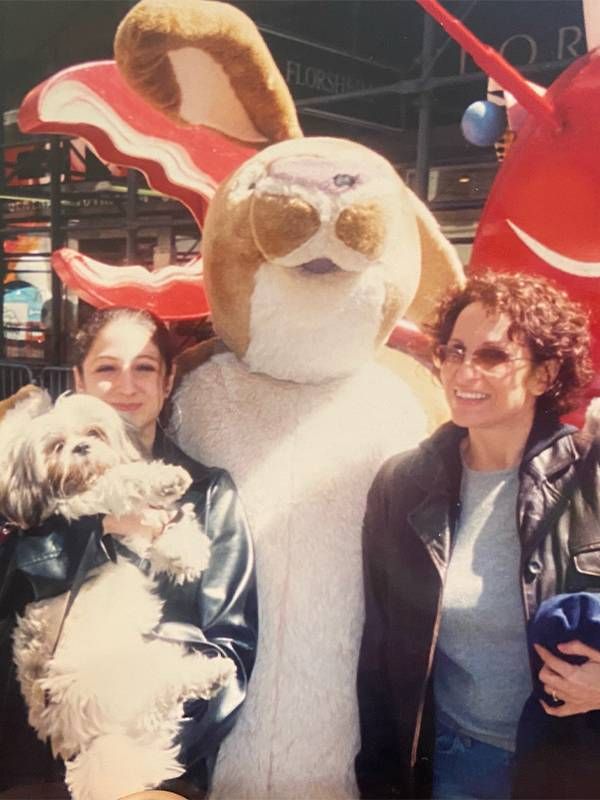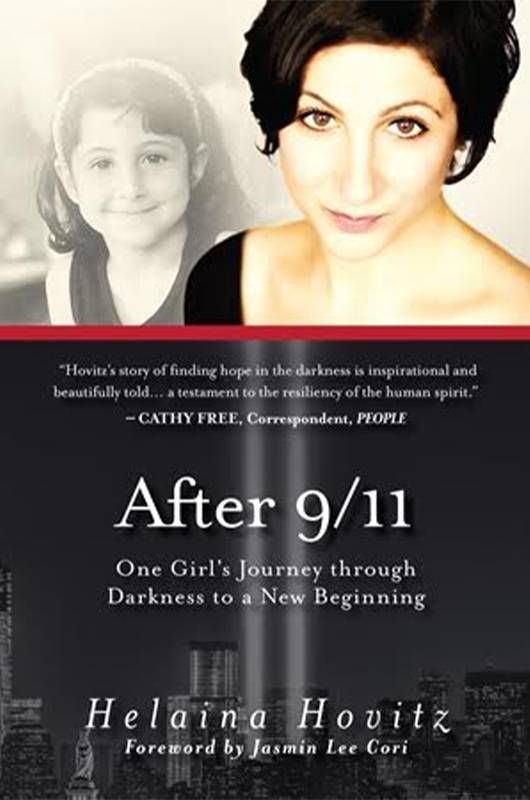On 9/11, I Was in Middle School 3 Blocks From the World Trade Center
The events of that horrifying day ultimately led me to a life of compassion
Editor’s note: This story contains descriptions of the events of September 11, 2001.

"Kids, pull your shirts up over your faces and run!" yelled my neighbor Ann. We turned and ran without looking back. People everywhere were doing the same. Middle-aged men ran alongside seven-year-olds and toddlers, all screaming and crying in unison. My entire body was throbbing, my feet, my face, my stomach, one huge pulse. More buildings are being bombed. Fighter jets are shooting at us.
I felt very dizzy, and suddenly I could feel my heart pulsing on the outside of my shirt at a speed so fast it scared me. I shouldn't be able to feel that without touching my hand to my chest. My vision suddenly blurred into nothingness as I tried to run as fast as I could.
The next few minutes are blank in my memory, a void where the next part should be — but Ann and her son Charles remember.
Voices shouted, "Get inside! Quick!"
A group of maintenance men and janitors pulled the three of us inside a building with a giant lobby, where we waited a few minutes for the smoke to clear.
When we stepped back outside, we saw people running, stumbling and sobbing. I looked down and saw what everyone was tripping over: underneath at least three inches of beige ash were dozens of shoes, bags and backpacks. Everything had been abandoned.
That's how fast everyone is running.
For the first time since we left school, I saw my face reflected in a dark store window, and only then did I realize I was crying, that the top of my shirt was wet with tears. For a moment, all of the noise stopped. There was a look in my eye I had never seen before, whites of my eyes that I didn't know existed.
I looked so grim and forlorn, covered in the white ash now whirling around us.
-Excerpted from the author's book, "After 9/11"
A Dark and Frightening Time
I was in I.S.89 middle school in Lower Manhattan, three blocks from the Twin Towers, on September 11, 2001. After the bomb squad burst through the school doors and told everyone they had to get out, Ann, Charles and I had no idea that a falling Tower was even a possibility.
In fact, we weren't even sure of what was happening around us — all there was was smoke, ash, running, fire and chaos. Rather than run uptown like everyone else, we ran farther into the area, desperate to get home to our apartment building just three blocks away but on the East Side of the towers, on the other side of Lower Manhattan.
Nightmares and flashbacks overhauled my days and nights. Fear would become the foundation, the jumping off point, of how I experienced life for the next 10 years.
The police refused to let us down any streets that led to home — trying to direct us uptown. It likely made no sense to them or to anyone that we'd want to keep running against the crowds of bleeding, ash-covered people, into the direction of where the sounds of bodies hitting cars was coming from.
But for us, it was our only option, because my grandparents lived in our building, and it was also the only place my parents would be able to find me. Eventually, after the first, then the second, Tower collapsed, we made it home using a route that was no longer blocked off; the police were gone.
By then, everyone was gone, or still trying to get out of the area. It remained that way through the night. The police were telling everyone that we had been evacuated, but no formal evacuation took place. There were still hundreds of us who could not evacuate, and nobody knew we were there.
How We Were Changed
In the days that followed, our neighborhood became a war zone infiltrated by The National Guard, barricades, police and people running and crying for no clear reason. We lived with spotty electricity and little access to food, water and medication. The skeletons of the Towers were still on fire.
Daily threats of more collapsing buildings and bomb scares on nearby landmarks like City Hall, the Brooklyn Bridge and Wall Street prompted me to keep throwing my belongings into a suitcase because we were getting mixed messages about needing to evacuate our building.

I was ducking when I heard planes passing overhead, then crying, panicking, sometimes running back and forth with nowhere to really go. Nightmares and flashbacks overhauled my days and nights. Fear would become the foundation, the jumping off point, of how I experienced life for the next 10 years.
We hear time and time again that children are resilient and will just bounce back from tragedy. That's partially true. That resilience literally keeps them going: waking up, brushing their teeth, going to school.
But just because a body remains in motion does not mean we aren't changed.
Kids want to try to stay strong and "move on," and to still be able to feel happiness and do well in school and in their day-to-day lives. While we are born with natural resiliency already in us, the rest has to be learned and cultivated over time, especially in response to a traumatic event — or exposure to ongoing traumatic events.
I Finally Became Me
As the rest of the city tried to get back to "normal," after 9/11, it became very clear to me that no matter how much I wanted that for myself, it was not going to happen. My teenage years were spent in and out of talk-therapists' offices and psychiatrists' chairs as I took dozens of medications and sought help for issues that nobody seemed able to fix, which left me feeling drained of hope.
Despairing that nothing would fix this hell that I was experiencing as life, I never gave up hope that I was not permanently broken, despite all of this evidence to the contrary.
I never gave up hope that I was not permanently broken, despite all of this evidence to the contrary.
At age 18, I reached out to a Cognitive Behavioral Therapist (CBT) who saved my life and got me started on the journey to begin a new one. Soon, CBT became DBT (Dialectical Behavioral Therapy), then I got sober at 22 and entered into 12-step recovery.
After that, I began EMDR (Eye Movement Desensitization and Reprocessing) therapy to reprocess the actual trauma itself. It took a lot of work, but it was work I tripped over myself to do. If there was a way to a better life, a better me than the one my trauma tried to take hold of all these years, I wanted it. Badly.
I was eventually able to feel safe, happy and calm in my own skin and in the world around me. I was able to take that 12-year-old girl who never had a chance to become a woman and raise her to become "me."
I was finally able to figure out who I could be if I re-learned how to respond to the world and myself, and how to cultivate qualities I'd never had the chance to because I was always just "surviving" from one day to the next throughout my teenage life.
Making Peace With My Experiences
"How do you feel reflecting back on that day twenty years later?" It's a question I've been asked many times, and it's far too big of a question to be able to simply answer.
What I do know is that when something like this happens to you, it shapes how you grow up and it's always there, whether you're actively thinking about it or not.
I have made peace with my experiences and have learned to live a happy and rewarding life despite my PTSD. But that does not mean that I have forgotten what I lived through. Nor does it mean I need an anniversary to remember it. In fact, it could even be said that a small part of my life is an ongoing reflection of that day.

Take, for example, the way I've been able to turn some very serious personal fears into a more positive way to live my life.
I was thrown into the "real world" during one of the most terrifying and tragic moments in American history — everything I thought I knew, and any feelings of safety or sense of emotional and literal security I had, were gone. At age 12, it was clear to me that there were no guarantees that our parents would be alive the next day or that we would either. I became terrified that something horrific would happen to the people I loved at any second. Now, that fear hasn't just vanished, it's the reason I try to stay in close touch with my friends almost every single day and never miss the chance to make them laugh or let them know how much I adore them.
It's the reason that I'm not a procrastinator, that I am constantly flying into action to try to turn my ideas into reality.
It's the reason that I constantly try to do nice things for folks "just because" and the reason I tell my wonderful husband, several times a day, "Thank you, I appreciate you, I'm proud of you, I love you."
I try to put more into the world each day than I take from it.
This past year (read: 2020-2021 and still going) has further solidified the fact that while you can't know when the next tragedy is going to strike, there is always something you can do to help yourself and help others. And there are ways we can try to stay safe, even when so much of life feels completely out of control.
Of course, throughout the pandemic, I have been worried for the safety of the people I love. But I've learned to cope with that fear and accept the reality of "what is." I hold on to my hope that the resiliency of the human spirit is indeed something we're all born with.
The greater hope I have for us all right now is that we will reach out for the help and support we need to keep moving through this new world we're in, finding a healthy way forward that brings as much inner peace as possible.

